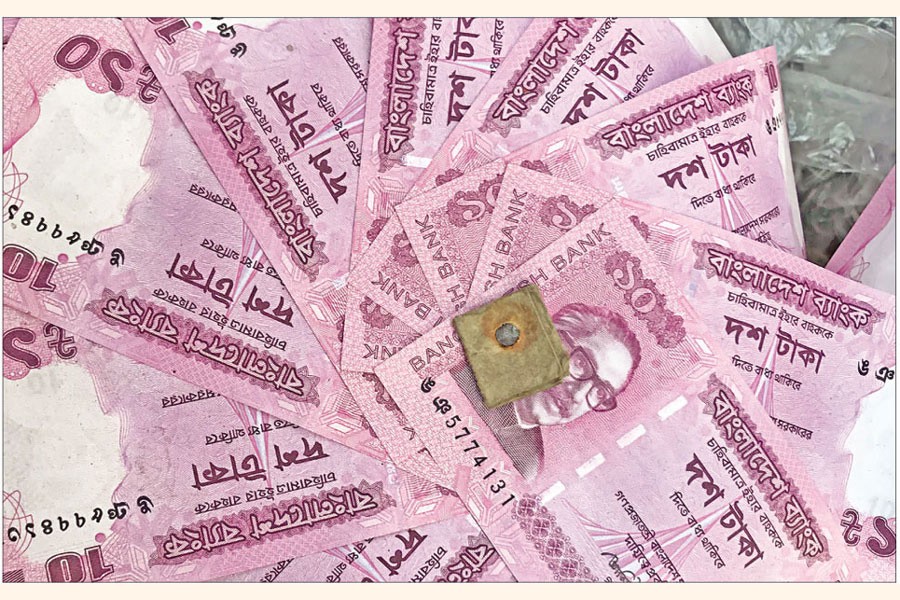
 Modern Monetary Theory or MMT has now been a much-debated concept globally, in matters of pivoting an economy in situations fair or foul. With normal course of life and business being upended, many central banks loved it during the COVID-19 peak period as a tool to rebound for their economies.
Modern Monetary Theory or MMT has now been a much-debated concept globally, in matters of pivoting an economy in situations fair or foul. With normal course of life and business being upended, many central banks loved it during the COVID-19 peak period as a tool to rebound for their economies.
Before coming to the fore in recent years, many western economists had leveled it as a muddle-headed concept as it does not consider the consequences of flooding money on the economies. Surprisingly, almost all advanced economies applied it to boost their economies during the pandemic upset when people's movement was restricted.
Bangladesh was no exception. The government has copied the idea of injecting fiat currency into the economy to revive economic activity. Neither the Bangladesh Bank nor the Ministry of Finance did inform the people that they have been pursuing MMT to breathe life into the economy. The developments that surfaced on the money market in Bangladesh during that emergency show us the country was in favour of the MMT. The central bank and the government injected or supplied an adequate amount of "fiat currency" into the economy during the corona calamity.
The MMT is a heterodox macroeconomic supposition that asserts that monetarily sovereign countries [almost all sovereign nations] which spend, tax, and borrow in a fiat currency that they fully control are not operationally constrained by revenues when it comes to central or national government spending. During a recession or crisis, resource mobilisation typically becomes lower. The MMT magic comes to save the situation -- it argues that sovereign governments do not rely on taxes or borrowing for spending since they can print as much money as they need to combat the crisis. It does not consider the inflationary pressures and other consequences on the economies. It says that after getting the money the economy breathes normally. It helps investment when the economy starts to recover and subsequently the unemployment as well poverty rate starts to fall.
Governments across the globe that are monopolies in issuing the "fiat currency" announced stimulus packages during the COVID peak period. The fiat currency or printed paper notes that we use as a medium of exchange is actually a decree by the government to abide by as legal tender. It does not have substantial backing to compensate the people. They [governments] are not in fears of rising national debt. In simple words, the government will spend money as long as it needs -- and this is the simplest definition of the MMT.
This monetary theory was at its zenith during the COVID-19 onslaughts in all economies, no matter whether they belong to G-7 or G-20. They all issued government bonds or printed money. And yet interest rates remained low. They also offered cheaper debt to the poor or developing nations to fight the COVID-related shocks.
Such debt or the creation of fiat currency had created an illusion of fiscal space -- the ability to run up debt without adverse consequences for the bond market or money market -- being limitless. People, especially those who lampooned the concept as "ridiculous", began to love it in the last couple of years as it worked well.
During the first week of April 2020, Prime Minister Sheikh Hasina unveiled a set of financial support packages worth Tk 727.50 billion to shield the economy from the impact of the coronavirus pandemic by providing low-cost funds to affected industries. There were two more packages, totaling more than Tk 1.0 trillion, injected into the economy. Subsequently, Bangladesh Bank formed a number of refinancing schemes to stimulate the economy. The central bank had favoured "quantitative easing" measures to stabilise the liquidity in the market. There are monies for the poor from the government side as many social-safety-net programmes were strengthened and many innovative ideas implemented.
All such funding or injecting funds -- debt, refinancing, or printing fiat currency -- is similar to that of the MMT theory. The central bankers or policymakers may adopt such strategies by copying the ideas of the western economies, especially in the USA and the European Union.
Bangladesh did well during the COVID-19 period as there were no liquidity shortages in the banking sector. Inflation was under control amidst the global supply- chain disruptions on grounds of higher freights as well as lockdowns across the globe. The remittance inflow and the export receipt were very much satisfactory, keeping the balance of payments (BoP) in the comfort zone. Many, however, argued that the remittance was good as the unofficial channel dried up during the period due to the restrictions on movement of people during the COVID-19 peak period. And export was satisfactory as Bangladesh exports essential or basic clothing the West needed for all citizens. The current account was in surplus.
Banking activity got boosted by digital transactions. It had adequate deposits although the interest on deposits was lower, 6.0 per cent or less. From the fiscal side, the government had adequate funds, keeping its deficit much below the target.
The economy has been picking up since the fag-end of 2021, but for a sudden setback caused by an unforeseen headwind. The war in Ukraine began in February last, and since then, Bangladesh's economy had started worsening. The balance-of-payments deficits were ballooning on a month-on-month basis amid higher import payments. Bangladesh sought IMF supports to narrow its deficits and the Bangladesh Bank started tightening import, discouraging luxury imports, amid forex crunch.
When money is supplied to an economy, it has some consequences -- some adverse and some positive. A popular theory on money is the "Time Value of Money". This is the concept that a sum of money is worth more now than the same sum at a future date due to its earnings potential in the interim. So the economy should have adequate money and the liquidity in the banking sector should be adequate. Surprisingly, the liquidity is now falling and the deposit growth also slowing down. This is undesirable when the economy is picking up as investment and employment are growing. Many banks are discouraging new projects.
The government which had adequate funds to support social-safety-net programmes and megaprojects is now pursuing policy of austerity. Office hours and schools and other educational institutions have been rescheduled to save power as the government feels shy of funding the power projects on grounds of dollar shortages.
The money multiplier is there, and growing at a steady rate. This is now over 5.0.
The pace of increase in public debt has gained strength and it will speed up further after receiving the IMF financial support. The reality is that the fiscal space which MMT believes limitless is now scarce for Bangladesh.
The possible reasons behind it need to be studied. But a layperson's view is: a part of the money has been invested in properties as their prices remained high. Property prices remained higher than even during the pre-COVID-19 period. The property developers argue that this is due to a rise in the prices of construction materials. A section of people in society has availed of it.
A part of the money was eaten up by soaring inflation as the rate of inflation remained higher for quite a long time. And the actual inflation may be much higher than the official statistics. The official statistics measure the old basket, for example, the 2005-06 fiscal year, which does not include many products and services including COVID-related costs.
And more importantly, a part may be siphoned off through a number of ways: under-invoicing and over-invoicing among them. Bangladesh in its latest media briefing held in November hinted that they had identified a number of transactions that they view as similar to capital flight.
However, the MMT zeitgeist was influential in the COVID years but now is sour as Bangladesh faces a liquidity shortage amid the growing debts. This conundrum of the government sparked debate over whether fiscal needs more funds for creating space or not. The dollar crisis may be one reason, but cannot influence the whole economy.
jasimharoon@yahoo.com
© 2026 - All Rights with The Financial Express
